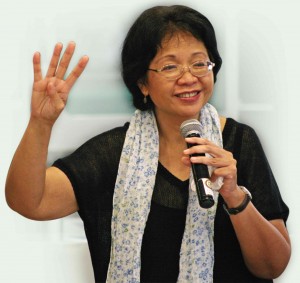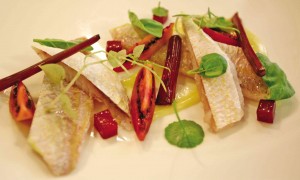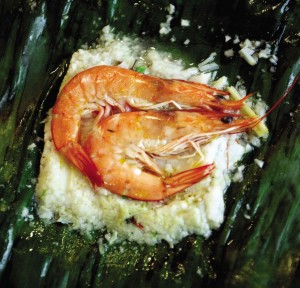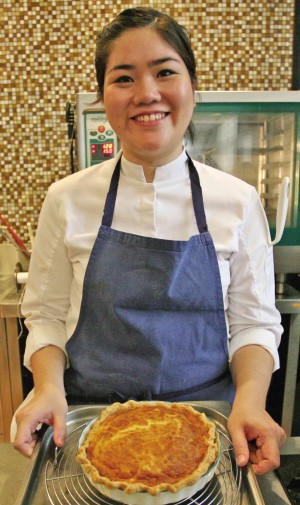Show-and-tell rich in local flavors
The cheese tart that chef Patricia Benedicto is demonstrating this day at Enderun Colleges in Taguig City is one of the three stars of the exclusive “Ang Sariling Atin” talk by restaurateur and award-winning author Amy Besa before an audience of bright-eyed culinary students.
“It made the cheese shine,” says Besa, adding that the four kinds of cheese that went into the tart are not cheap for certain reasons. They are handmade from pure, first-rate ingredients at Malagos Farm in Davao. The tropical climate’s toll on production makes them even more expensive.
At Purple Yam Malate (PYM), according to Besa, the tart is served with a guava compote created by head chef Joseph Galvez from native guavas and siling labuyo.
“We should use our guavas because they might disappear. Our small, native guavas are packed with flavor and aroma,” Besa says as Galvez prepares the compote. “The labuyo is also something you have to worry about … it’s very hard to grow and the birds are your main competitors.”
PYM, named after the modern Filipino restaurant Besa and her chef husband Romy Dorotan operates in Brooklyn, New York, opened just this year in Besa’s ancestral home on Julio Nakpil Street in Malate, Manila. Among those manning the kitchen in the physical absence of Dorotan, who is back in Brooklyn, are Galvez and Benedicto, both of whom are Enderun alumni.
The unconventional metrics of both the tart and the compote hint at PYM’s commitment to cultural mindfulness and pride, the topic of today’s special session. Besa’s passion is looking for ways to marry local ingredients with Western methods of cooking to create the most wonderful of dishes. It is an advocacy that she seems to have passed on to her young chefs.
The second dish in the showcase, confit of bisugo, transforms the everyday red fish into a delightful entree. The fish is filleted and fermented with salt to firm up before slow-cooking in coconut oil mixed with a handful of sliced kalamansi. The oil is thereafter used to make mayonnaise.
For garnishing, Galvez presents some sliced purple Spanish tomatoes sourced from Benguet province, as well as sugar beets and sugar beet stems. He also adds talinum and pancit-pancitan, two kinds of greens from the selection PYM uses for its salad. (The other native greens in the PYM salad, says Besa, are talbos ng sayote, takip-kuhol, kanunay, watercress, spinach and other local herbs. Lettuce is a no-no.)
The last but definitely not the least dish is a take on the kinagang, a delicacy from Sorsogon province that originally uses fermented talangka on a bed of ground coconut meat (lukadon), wrapped in hagikhik leaves and steamed. In the PYM version, crab meat is mixed with the lukadon, topped with lemon grass stalks, mint leaf and fresh shrimp, wrapped in banana leaf and steamed for several minutes.
The modernized kinagang “brings back an old flavor,” says Besa, “by using ingredients that are local and methods that are Filipino.” It is a reimagining of something that has been done one way for generations, which seems to be the mantra at PYM.
In her talk, Besa shares a sampling of the vocabulary that has won her awards as an author. For instance, she says the hagikhik leaf can lend a lemony flavor to food wrapped in it and that the karimbuaya leaf is used as stuffing for Ilocano lechon. She says that she recently found taro from Quezon province called galyang.
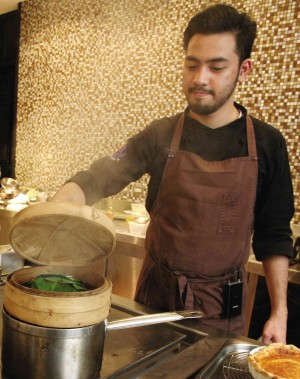
CHEF Joseph Galvez, themastermind behind the confit of “bisugo,” steams the “kinagang,” another PYM masterpiece.
Sourcing has become an Amy Besa art. It is not unusual to find her at bus depots picking up products that came all the way from Sorsogon, Benguet and other places. PYM also serves entrees using meat from cows that eat only grass because families in some parts of Negros Occidental province are too poor to give them anything else.
At their New York restaurant, says Besa, even back in 2005, they have been serving heirloom rice, types of rice exclusively planted by certain Filipino clans.
Because there is still so much ground to cover, PYM’s menu is still pretty much open for more enlightened ways to serve delicious, healthy and quality food made from local ingredients.
Besa says Filipinos will just have to get over the idea that foreign is better than local.
There are two steps to achieving a healthy food system in the country, according to Besa. First, you have to be aware of the ingredients around you. Next, you put a price on them.
“When somebody makes good products, we need to learn to pay for them,” Besa says. “With a better palate, you learn to pay for the price … Of course it’s challenging but I think there is enough of a market right now. It’s a lot better market than 10 or 15 years ago.”
She is confident that all plates served at PYM have premium food on them. That’s also why, she says, “I refuse to be cheap.”
It is all about education, she says. “More and more it’s about how you turn this new crop of culinary grads into fantastic chefs who can run with whatever fresh ingredients are available,” she says. “What we’re doing is we are working with the seasons. How many of us really take advantage of the fruits in season? Like the santol. Other than santol jams or preserves, what else can we do with it? Using it as a salad dressing is another way. Would you believe that the salad we served with santol dressing is one of our popular dishes? People asked for seconds. That was a milestone, for Filipinos to ask for another serving of salad.”
But it is not enough to encourage future chefs to use local, organic products so Filipino farmers will continue producing them. The key, too, is in educating the diners. “When people understand that they’re eating real, natural food as opposed to manufactured food, that’s a start.” If a person is made aware of the differences between the two and that person goes for real food, says Besa, “it’s a victory for us, pure and simple.”
To her, even if it’s only one person, it’s worth all the effort. “Then one becomes two and then it multiplies,” she says.
To wrap up, Besa tells her Enderun audience, “What you tasted today is a very, very small fraction of what we have [in the Philippines]. We are rich in flavors because we have 12 months to grow things. In other parts of the world, they can’t do that because of autumn and winter.”
All in all, Besa’s talk, in tandem with cooking demos and tastings of dishes using sariling atin ingredients, leaves the students inspired, pleased and satisfied.
